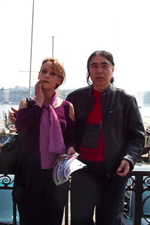> [Archived] Chronicles

An American rewiew about the last issues on Edition Modern label
Rumanian composers Iancu Dumitrescu and Ana Maria Avram consider the conductor and philosopher a guru, and his conducting is quite similar to the music on these three new Edition Modern releases.
When Celibidache conducts, no matter how diverse his repertoire, the music moves through a very personal series of states, or moments, rather than being goal-oriented in any traditional sense. It isn't simply that each phrase is treated as an entity; whole sections of music move past as if each is contained in a galaxy, each moment or detail separate while the whole section is also somehow coherent in itself rather than coming from the last or leading directly to the next.
Dumitrescu and Avram's music is a logical yet hugely varied outgrowth of this aesthetic.
Fragments abound, dynamic levels can be earsplitting, and yet, inexplicably, there is a sense in which action is avoided in favor of something contemplative, or meditative.
That said, the timbral diversity on offer is staggering, especially in the way acoustic and electroacoustic sounds merge. Just for clarification's sake, Live in London II is the second disc of performances from London's Conway Hall in 2008. The first (Ed.Mn.1025) involved the IO String Quartet, while this one features Dumitrescu's Hyperion ensemble, well-known to anyone following the Edition Modern series. As with all other volumes thus far save the first, the discs are split between compositions by the two composers.
Dumitrescu and Avram's pieces for large ensemble are like no others I've heard, with the possible and surprising exception of those by John Coltrane, whose 1965-67 works (Ascension and Meditations in particular) share a penchant for relatively static structures that nevertheless teem with inner life.
Avram's Noumina almost resembles a series of connected tableaux, beginning with what sound like tympani glissandi dotted with small gongs and trombone interjections. Even as the dynamic level changes, there is no sense of dramatic becoming, as might be expected in what I'll sweepingly label the Western canon. The volume rises and falls, trombones rasp and clarinets emits expertly placed multiphonics, but there is a certain calm at the heart of it all, even at moments of high density. The piece ultimately fades to the silence that seems to pervade it at key moments.
A similar stasis imbues Dumitrescu's Roots and Rizoms, this time in the pitch domain. Dynamics are much more fluid here, the oceanic construct centering itself around a pitch complex that slowly fragments and dissipates over 15 minutes of wave upon wave, again ultimately leading nowhere save back to the material that spawned it. Dumitrescu's "Extreme Point of Gravity," from the St. Luke's disc, recorded in 2009, adds an extra ingredient: when the boiling ensemble passages fade, a kind of ghostly spatialization occurs, so that the clarinets seem to disappear gradually into the distance rather than simply approaching silence. The effect is extraordinary.
We are given the chance to compare two versions of the same work in Le Silence D'Or, presented in London and Israel versions and performed by the Hyperion Ensemble and the Israel Contemporary Music Ensemble. The ingredients are the same, a dialogue between group and what seems to be electroacoustic timbres, but the execution is radically different. The London version is heavier, steeped in brass and percussion, while the Israel version integrates acoustic and electroacoustic sounds more completely, due largely to Assaf Talmudi's accordion. It's a stunning instrument in his hands, taking on the soundscapes' sudden dynamic shifts, even sounding like a backwards piano at strategic moments.
What Dumitrescu and Avram call "computer sounds" may be the most unique texture of all. I remember thinking, on first hearing Xenakis' La Légende d'Eer, how incredibly human his timbres sounded. The Rumanian composers evoke a similar gestalt: Cologne bleeps and bloops are nowhere to be found, but neither are the cinematic concerns of the French composers. Listen, for example, to the birds on Silence D'Or. It's as if they're slightly enlarged, something like Merzbow's frogs, but not nearly as threatening, and they constitute one of the only immediately recognizable timbres on offer. These sonic projections do not tell a story, nor do they exist in abstraction. Many verge on recognizability and then vanish again. At certain points, I can hear instruments from the ensembles being manipulated, though the effect in the hall must be a hundred times more pronounced.
After living with these discs, the music strikes me as exploring, even transforming, the space in which it exists rather than invoking any external narrative. In this regard, it is helped by a few guest soloists, such as the always exciting and virtuosic Tim Hodgkinson, whose bass clarinet artistry, along with that of Rane More, graces Avram's Textures 3/Penumbra, from the St. Luke's concert. Both players can place and shape a tone with such initial subtlety that I was unaware of it until it began to oscillate, filling the soundstage against a backdrop of computer generated drone and delicate high-frequency webbing. The same is true of Stephen O'Malley, who joins the ensemble in Israel. As with the more recent Sunn 0))) material, his playing flavors what goes on around it, especially on the hits, smears and near-silences of Liminal Involvement for Ensemble. The recordings are all superb, and the captured pitch spectrum is jaw-dropping, from the deepest bass to highs that leap from the speakers and fill the room. Such spectacular engineering brings this uncompromising music to life, and any of these three discs would make an excellent introduction to Dumitrescu and Avram's musical vision.-MM
Three works for computer from Iancu Dumitrescu and one from Ana-Maria Avram, each a radical works of spectral music in tribute to ILan Volkov, Andy Wilson, Ben Watson and Stephen O'Malley.














